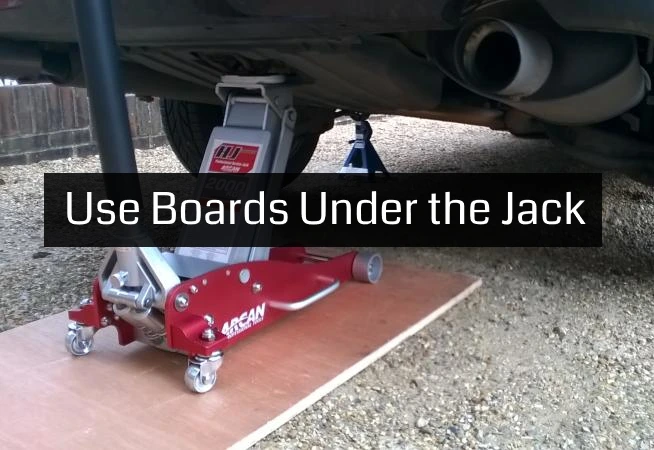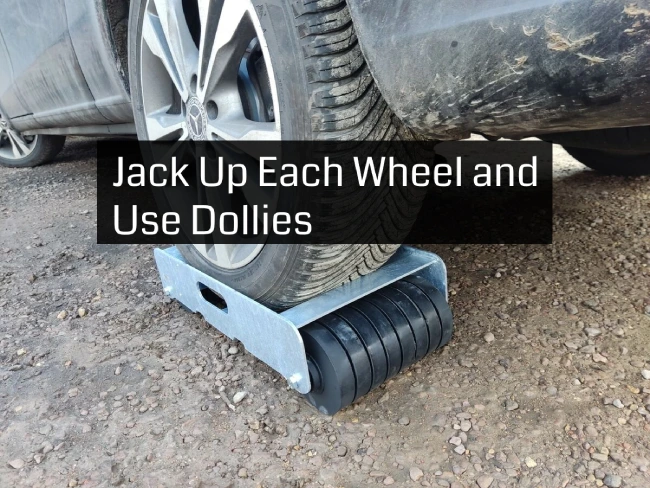Jacking up a car is a common task required for changing a flat tire, performing maintenance, or making repairs underneath the vehicle. However, choosing the right surface is crucial to safely support the weight of the car while it is raised. Jacking up on an unstable surface like gravel has considerable risks compared to a solid, paved surface.
Why Gravel is Not Ideal for Jacking Up a Car
There are a few key reasons why gravel is not an optimal surface for jacking up your vehicle.

Gravel can shift easily, causing the jack to slip
First, gravel can shift and sink easily under the weight of a car. This means that as you start to raise the vehicle with the jack, the gravel underneath can start to disperse and compact. This has the potential to cause the jack to slip out of place or sink into the gravel, risking the stability of the car.
There is no firm base to support the jack and hold the car’s weight
Similarly, the loose gravel provides no truly firm base to evenly hold the full weight of the car once it is lifted. The car’s weight pressing down can cause the jack stand to gradually shift and sink.
Risk of the car falling off the jack and becoming damaged or injuring someone
Most concerning is the increased risk that the car could fall off the jack when lifted on a gravel surface. If the gravel compacting leads to the jack slipping even slightly to the side, it can compromise the vehicle’s balance.
Additionally, if the base is uneven, the jack may tilt the vehicle to one side as it is lifted, again creating the potential for the car to fall from the jack. If this occurs, the car could become seriously damaged, especially if falling from a significant height on the jack. Even worse, a falling vehicle has the potential to seriously injure someone nearby if the car drops unexpectedly.
Safety Precautions When Jacking up a Car on Gravel
Use Jack Stands with Base Plates
After lifting the vehicle with the jack, immediately place jack stands underneath to support the car. The jack stand’s wide, flat base helps disperse the weight instead of concentrating it on a small point. For added stability on gravel, use base plates underneath the jack stands to provide a broader, solid surface and prevent the stand from sinking.
Position the stands on the hardest, flattest section of gravel you can find. Make sure the saddle/head at the top is properly aligned with the car’s jacking point before transferring the weight onto the stands.
Engage Parking Brake and Chock Wheels
Before lifting, make sure the parking brake is firmly set to prevent the vehicle rolling unexpectedly. Additionally, place solid rubber wheel chocks or blocks both in front and behind the wheels that will remain on the ground. This provides a backup to immobilize the car from moving.
Lift One Wheel at a Time
Rather than jacking up one whole side or end of the car, only raise one wheel at a time when working on gravel. This puts less overall strain on the jack and gravel surface, enhancing stability. It also lets you reposition the jack more easily if it begins to shift or tilt the vehicle.
Use a Wide, Stable Jack
Avoid scissor jacks or other narrow jacks intended for emergency use only. Opt for a wide, stable hydraulic floor jack or botttom-lift jack instead. The wider the jack’s base, the less likely it will sink into the gravel under the car’s weight. Choose a jack with a large, curved saddle that can better cradle and grip the car’s jacking point as well. Make sure the jack sits flush against the chassis.
Check Vehicle is Lifting Evenly
As you start to crank the jack, pay close attention that the vehicle is lifting evenly and naturally coming to level. If the car seems to be tilting heavily to one side, stop jacking immediately. This indicates the jack is on unstable ground and at risk of tipping over. Reposition the jack and try again, making minimal lift height adjustments at a time.
Use Boards Under the Jack

Carry boards in your car to place under the jack when working on questionable surfaces like gravel. Thick wooden boards help evenly distribute the jack’s pressure and prevent it from sinking. A pair of boards positioned perpendicular to the car can provide a stable, flat jacking platform when gravel is uneven.
Have an Assistant Present
An extra set of eyes on the vehicle and jack is vital for safety when lifting on gravel. Have an assistant stand near the car and keep watch over the jack’s position. They should alert you to any shifting right away so you can lower the car and re-adjust. They can also spot check for level lifting and slipping hazards.
Use Jack on Flat, Level Ground
Scan the gravel area and select the flattest, hardest packed section you can find. Avoid jacking the car up on an incline or curved driveway area. The jack needs a level plane to apply uniform lift to the vehicle. Dig out any large rocks or debris from the chosen spot that could cause the jack to tilt.
Never Get Under the Vehicle
Perhaps most importantly – do not put any part of your body underneath the car when it is lifted on gravel. The risks are simply too high for the vehicle to fall. Complete all needed repairs or maintenance only from the sides, not underneath. If access underneath the car is mandatory, seek out professional help.
Alternatives to Lifting on Gravel
There are several safer alternatives to lift the vehicle first before performing any repairs or maintenance.
Jack Up Each Wheel and Use Dollies

One secure option is to jack up one wheel at a time and place it on a solid dolly, then repeat for the remaining wheels. High quality metal or rubber dolls are designed to hold thousands of pounds per wheel. Make sure to engage the parking brake and chock the opposite wheels when lifting each one. The key is to individually lift just one wheel safely on the gravel using all precautions.
Once each wheel is supported on its own dolly, the entire vehicle can be slowly and carefully rolled onto a hard, flat surface like concrete or asphalt. The car can then be safely jacked from this stable base to perform work.
Carefully Drive or Push onto a Solid Surface
If your gravel driveway or parking area has access to a paved surface, consider carefully driving the vehicle or pushing it by hand onto the pavement before jacking. This may be an option for properties with both gravel and poured concrete or asphalt sections. When driving, inch the car forward slowly and avoid any abrupt acceleration or turning. You don’t want the wheels spinning rapidly on the gravel.
Go slow enough to maintain control but keep momentum toward the pavement. Having a spotter guide you helps ensure you stay centered and avoid sinking wheels. Once positioned on the solid surface, the vehicle can be jacked up securely using proper precautions.
Use Automotive Ramps on Gravel
Quality automotive ramps provide an alternative way to safely access the underside of a vehicle on gravel, without needing to fully jack up the car. These ramps have a broad base and low incline that can be positioned on gravel without sinking significantly. Carefully drive the wheels onto the ramps until they contact the stops. This raises the car a foot or more off the ground, depending on the ramp height. Proper wheel chocks and the parking brake are still recommended for stability. The benefit of ramps is you can access the underside without lifting the full vehicle weight far off the ground. Use care not to get any body parts under the car when using ramps.
Additional Options to Consider
A couple other alternatives include:
- Using ground clearance to your advantage. For some maintenance like oil changes, you may be able to access the drain plug without jacking by sliding underneath on a mechanic’s creeper.
- Calling a professional mobile mechanic. Reputable services will have specialized equipment to safely lift vehicles on unstable ground. This option costs money but provides peace of mind.
- Temporary gravel displacement. Shovel gravel out from wheel areas and replace with solid wood or composite boards to create temporary stability.
When Jacking on Gravel Can’t Be Avoided
In these situations where jacking on gravel is unavoidable, extreme care must be taken to lift the car safely.
Take Every Possible Precaution
If you have no choice but to jack on a gravel surface, go in with the mindset that this is a high-risk procedure. Take every precaution available to help stabilize the vehicle and reduce the chance of slipping or tipping while lifted. These precautions include using a wide-base jack, adding wooden boards beneath for support, employing redundant jack stands with base plates, chalking wheels, and only lifting one end at a time.
Check that the jack is on the flattest, hardest packed section of gravel you can find. Carefully clear the area of any large rocks or debris that could cause shifting. Lift the vehicle slowly, stopping frequently to check the jack and vehicle position. Have an assistant stand near the side being lifted to watch for any settling or tilting of the jack stand.
Don’t get underneath the vehicle and keep body parts clear while lifted. Only raise the car high enough to get the tire barely off the ground. Overall, take it extremely slow and be ready to lower the vehicle at the first sign of any instability.
Lift the Car Only Briefly When Necessary
When jacking on gravel, you want the wheels to be in contact with the surface for the absolute minimum time required. Prolonged lifting dramatically increases the chances of a failure as the jack stand sinks deeper. Only keep the vehicle raised briefly to change out a flat tire before lowering immediately back down.
Avoid any complex or lengthy repairs where extended lift time is needed. Similarly, do not lift and leave the car unattended – keep eyes on it at all times when up on the jack. Quickly completing the required tire change or adjustments then lowering right away minimizes risk exposure.
Have Multiple Spotters Watching the Lift Points
With an unstable jacking surface like gravel, extra observers around the car are essential. Ideally, have two people watching the vehicle in addition to the one operating the jack. Position one spotter at each corner being lifted to constantly monitor for any shifting or sinking of the jack stand. Tell them to alert you to stop lifting immediately at the first hint of movement so adjustments can be made.
The goal is to have multiple sets of eyes on all lift points so problems can be caught early before developing into a dangerous situation. Take things slowly and communicate clearly with all spotters throughout the process. Only lift when everyone is ready and attentive.
Consider Calling a Professional Mobile Mechanic
The safest option when faced with jacking on gravel is to avoid doing it yourself entirely. Look for a reputable professional mobile mechanic service in your area that can dispatch an expert to your location. These mobile technicians will come equipped with specialized equipment designed to safely lift vehicles on unstable surfaces. This includes extra wide jacks and stands, massive base plates to distribute weight, and other commercial-grade gear.
While hiring a mobile mechanic costs money, it provides peace of mind knowing the job will be done safely. They also have extensive experience with precarious lift situations. Some situations like flat tires can also be quickly remedied with mobile tire installation so lifting is avoided.
Closing Thoughts
Jacking up a vehicle on gravel poses inherent risks that should be avoided if at all possible. But with the right tools, techniques and preparedness, short lifts can be done safely when absolutely necessary. The key is to take the job seriously, employ every precaution, and keep the wheels down for the minimum time required. For optimal safety, have a professional perform the lift when feasible.
Engineering Coordinator with 5+ years of experience in the automotive manufacturing industry. Currently supporting vehicle development and new model launch activities at Honda Development and Manufacturing of America. Skilled at managing engineering teams, overseeing prototype builds, coordinating testing, and driving continuous process improvements. LinkedIn








